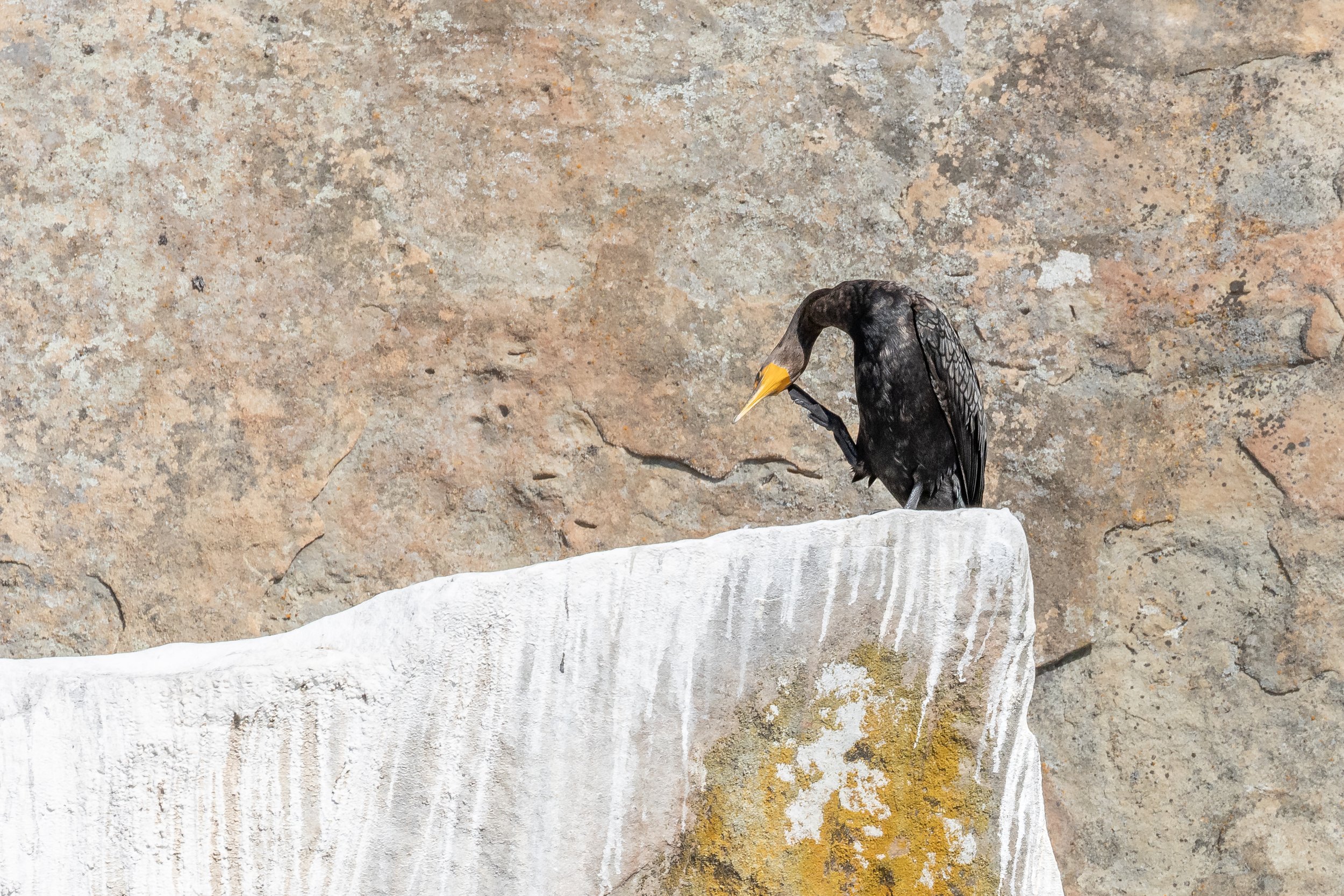September 16th - Mammoth & calf by Entrance Island and Strike by Ruxton Pass
Our tour today started with the boat heading around the north end of Gabriola Island where we found Mammoth and her calf just east of Entrance Island. The pair was resting at first but once they woke up they began foraging. We even got a breach from the calf! Mammoth has been hanging around the Salish Sea since at least 2016 but has not been matched to a breeding ground yet. This past January she would have given birth to the calf we have seen her with all summer. This little one was likely about 12 feet long when they were born and already weighed in at nearly 2000 lbs.
From the moment they were born Mammoth and her calf had an incredible bond. Mammoth likely talked to her calf in hushed whispers, so as to avoid drawing attention from the rowdy boys nearby. While male humpbacks aren’t known to attack calves, they don’t really have a concept of how big and strong they are and could unintentionally cause a lot of damage, if not kill the calf, should they get too rough trying to get close to Mammoth.
Mammoth has been nursing her calf all year with her rich milk. At up to 60% fat content the milk has helped the calf grow rapidly, as humpback calves double in size in just one year. The little one relied on Mammoth’s milk to make the migration to our waters where they have been watching mom and learning how to forage in our nutrient-dense sea. Humpback calves get only one year with their mom, sometimes less! In that short year they must learn the migration route, where the feeding grounds are, and the best feeding techniques, along with how to protect themselves and avoid predators.
The little whale has been growing big and strong all summer and has likely begun to ween off mom’s milk as they start foraging for their own food, putting to use all the teachings from mom. Soon these 2 will depart our waters and make their way to Mexico or Hawaii. Hopefully, mom has taught the little one well and both have found enough food this season to build up the fat stores they will need for their migration. Once humpbacks leave our waters they don’t eat again until they return next year. Building up their fat reserves in the Salish Sea is crucial to their survival.
If Mammoth has done her job right, next summer this little whale should return to our waters to feed on the fish and krill. They won’t have moms milk to sustain them this winter, and they will have to make the migration next spring without her. It’s thought that about 25% of humpback calves do not make it through their first year of life, but hopefully Mammoth has been a good mom and her little one is prepared for life after she leaves.
After we left the pair we travelled into the gulf islands and found Strike still hanging out near Ruxton pass. She was travelling in small circles, still foraging on all the tasty little krill and fish in the waters. Strike is a confirmed female, and being without a calf this year, we have to wonder if she will return next year with a young one in tow. We’ve noticed female humpbacks hanging out in groups with other females the year before they return with a calf. Strike hasn’t been hanging out with many other whales this year, but that doesn’t mean they aren’t carrying a little one with them. We will have to wait and see if she returns next year and we have our fingers crossed for a new addition to the Salish Sea humpback family.
During our trip, we also stopped to see other wildlife. Take a look at the photos taken by marine naturalists Vanessa Vereschahen.
Mammoth (KEX0023). Photo by Vanessa Vereschahen.
Mammoth (KEX0023) and her 2022 calf. Photo by Vanessa Vereschahen.
Mammoth (KEX0023)’s 2022 calf. Photo by Vanessa Vereschahen.
Mammoth (KEX0023). Photo by Vanessa Vereschahen.
Mammoth (KEX0023). Photo by Vanessa Vereschahen.
Mammoth (KEX0023). Photo by Vanessa Vereschahen.
Mammoth (KEX0023). Photo by Vanessa Vereschahen.
Mammoth (KEX0023). Photo by Vanessa Vereschahen.
Mammoth (KEX0023). Photo by Vanessa Vereschahen.
Mammoth (KEX0023). Photo by Vanessa Vereschahen.
Mammoth (KEX0023). Photo by Vanessa Vereschahen.
Mammoth (KEX0023). Photo by Vanessa Vereschahen.
Mammoth (KEX0023). Photo by Vanessa Vereschahen.
Mammoth (KEX0023). Photo by Vanessa Vereschahen.
Mammoth (KEX0023). Photo by Vanessa Vereschahen.
Mammoth (KEX0023) and her 2022 calf. Photo by Vanessa Vereschahen.
Mammoth (KEX0023) (fluke) and her 2022 calf. Photo by Vanessa Vereschahen.
Mammoth (KEX0023)’s 2022 calf. Photo by Vanessa Vereschahen.
Mammoth (KEX0023)’s 2022 calf fluke! Photo by Vanessa Vereschahen.
Strike (KEX0045). Photo by Vanessa Vereschahen.
Strike (KEX0045). Photo by Vanessa Vereschahen.
Strike (KEX0045). Photo by Vanessa Vereschahen.
Strike (KEX0045). Photo by Vanessa Vereschahen.
Strike (KEX0045). Photo by Vanessa Vereschahen.
Photo by Vanessa Vereschahen.
Photo by Vanessa Vereschahen.
Photo by Vanessa Vereschahen.
Photo by Vanessa Vereschahen.
Photo by Vanessa Vereschahen.
Photo by Vanessa Vereschahen.
Photo by Vanessa Vereschahen.
Photo by Vanessa Vereschahen.
Entrance Island. Photo by Vanessa Vereschahen.
Dodd Narrows, Northbound. Photo by Vanessa Vereschahen.
Dodd Narrows, Southbound. Photo by Vanessa Vereschahen.



































